Traditional and Medieval bread recipes
© Satu Hovi 1998 / 2017
No part of this text is allowed to be cited or published without my permission. Please note that methods of research get better all the time, and new interpretations may appear.
Leavens
Pliny describes a number of leavens, including dough left to ferment from the previous day’s mix, as well as cakes made of wheat bran and the fermenting barm of wine. According to Storck & Teague the superiority of Roman breads was not due to leavens, but to the wheats used and to the greater attention given to sieving. (Stock & Teague, p. 87)
There are many ways to make sour leaven (Luomuleipojan käsikirja). All grain can be leavened. Different methods are rye leavening, honey leavening, oat sour and sour of salt and honey (Luomuleipojan käsikirja, p 49-50). Simonetti writes that hops can also be used to leaven bread (p.154). According to Israelsson vehka (swedish missne) leavens the bread by itself.
Leaven raises the bread and no yeast is needed. Leavening is slow work: at least one day for raising after the leavening is made. Leavening changes strongly the taste of the ingredients: long leavening makes an aromatic and a strong taste. Salt or other flavors are not needed. Leavening effects baking, preservation and forming of taste. (Luomuleipojan käsikirja, p. 106). Under right preservation leavening stays well a long time. If the water is replaced with sour milk leavening happens more quickly. Leavening makes the bread more coherent; that is why leavening is mostly connected with rye flour.
Good leaven base can be centuries old. According to Luomuleipojan käsikirja (p. 49) somewhere in Finland a leaven from 18th century is still in use. The older, the better taste. New leaven working its first times can taste a little too bitter. Always a good leaven has been appreciated. It was the pride of the mistress of the house. I think that it is possible that a daughter getting married took a piece of the leaven base from the home of her birth with her.
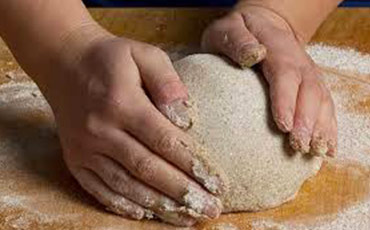
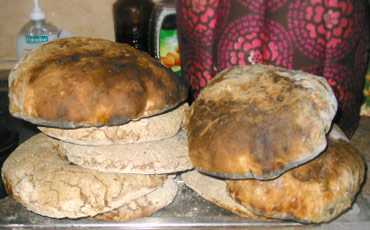
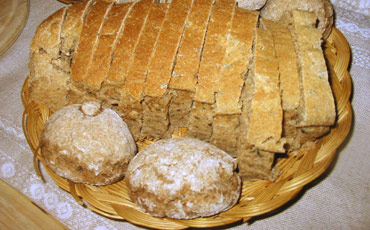
Honey leaven
Honey leaven is based on natural yeast of the nectar of the honey, which starts to ferment by the effect of water and warmth. To continue, the temperature should never go over 40 Celsius (about 80F), otherwise the yeast activates itself and is no longer of use. Only unheated honey can start the fermenting process, so when you buy honey make sure it has not be heated! Honey leaven is often used for wheat, because it has milder taste than an ordinary leaven. Anneli Schöneck recommends honey leaven especially when using barley flour (p. 50).
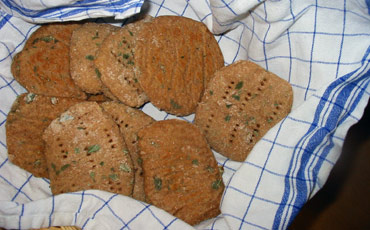
Oat leaven
Oat leaven was invented long ago when the leftovers of porridge were left into the sun for a day or warmth during the night. After a day and night the porridge bubbled and started to smell as yeast and its color changed. The good flavour and taste-giving substances of the former porridge were soon noticed (Luomuleipojan käsikirja).
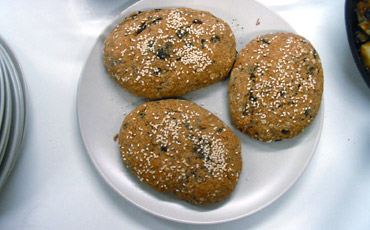
Salt and honey leaven
Salt and honey leaven raises with spontaneous yeast, which grows into the leaven during the long raising time. No special leaven base is used, the baking is started from scratch every time. Fermentation goes through all dough making maybe the best tasting wheat bread. A long heating time changes the starch into sugar and the bread gets dark color and a sweat taste. Salt and honey bread is as its best after a couple of days and stays soft a very long time. (Luomuleipojan käsikirja, p. 50 and 129).

Hot leaven
Before making the dough, when baking dark bread, often a part of the flour is separated and mixed with hot water. The mixture is to left overnight. Then the starch sticks, the flour dissolves into the water and the bread becomes succulent. The mixture can also be used soon after it has cooled, not in the following morning, when it usually is mixed into leaven dough. This method can be used also when baking with other flour than rye. (Schöneck, p. 48).
Making a rye leaven
The best temperature for fermenting rye leaven is 28-30 Celsius, that is, the warmth of your hand. If the water used is warmer than that, lactic acid will be formed. If the water is too cold, acetic acid will be formed. A strong, bitter taste becomes when fermenting is processed in lower temperature using a tight dough (flour 65-70 % from liquid) (Luomuleipojan käsikirja, p.107). The leaven starts to ferment, if the leaven ferments longer than 4-5 days.
This is how to start:
3 tabs fresh rye flour
3 tabs lukewarm water
Mix the ingredients and put into small pot covered with a towel. Leave for 2 days into a warm place. On the third day add 2 tabs rye flour and 2 tabs water. Mix carefully. Leave for one day. On the fourth or fifth day you can make a dough for rye bread. You need 8 dl water that is 37-Celsius warm , 6 dl flour and 2 tabs of the leaven mixture from your pot. Mix the ingredients in a tub. Leave for 12-14 hours. Remember to save rest of the mixture for the next baking time. (Luomuleipojan käsikirja, p. 111).
The leaven preserves best when dried in a wooden tub. You can also put it into the fridge. A few days as a loose leaven, for longer use harden the leaven with flours and soften it in liquid when you bake next time. (Luomuleipojan käsikirja, p.111). You can also attach the mixture to a linen towel and let it dry. Next baking day just wash the towel in the liquid in the baking tub.
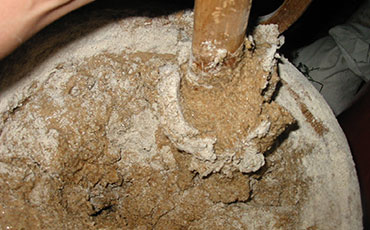
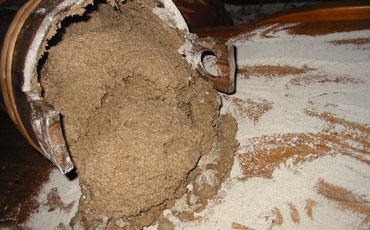
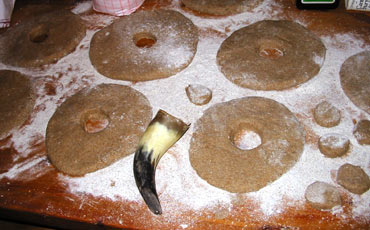
Making an oat leaven
Here is a quick sour oat recipe: mix 3 dl water and 2 dl oat flakes together. Put the mix to a pot with some kind of cover, non- aluminium one. Heat the oven to 50 Celsius, take the heat off and put the pot into the oven for overnight. Light bubbling will perform or your mix will get a white cover, other changes of color should not exist. If there are, try again. (Luomuleipojan käsikirja, p. 119).
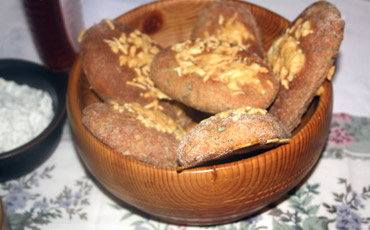
Making a honey leaven
The process of making a honey leaven takes three days. On the first day put into jar made of glass:
0.5 dl water, 40 Celsius
2 tabs fine graham flour
1 tap honey
Let it stay covered with towel for 24 hours in the warmth of 25-35 Celsius.
On the second day add:
almost 1 dl water, warmth of 40 Celsius
1 dl fine graham flour
Mix them well and on the third day add:
almost 1 dl water, warmth of 40 Celsius
1 dl graham flour
If everything goes as planned, the mixture will bubble in half an hour. Put the cover for the jar on carefully and let it stay in the fridge. The leaven is useful for several months. Some gray color will appear into the top of your mix. It is yeast fungus. The water will fade away little by little. (Luomuleipurin käsikirja, Schöneck).
To increase your honey leaven:
1 brimful tap honey
1 tabs honey leaven
1 dl graham flour
1 dl wheat flour
1.5 dl water, warmth of 40 Celsius
Mix all flour to warm water, add honey and leaven. If the the warmth is 25-35 Celsius, the mixture is usable in 12 hours. (Schöneck).
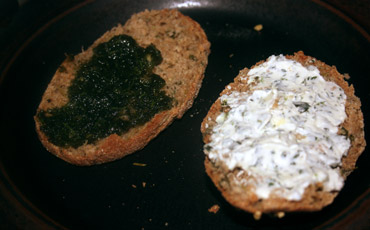
Recipes from the Middle Ages
OF BAKING MANCHETS from Gervase Markham: The English Hus-wife, 1615:
”Now for the baking of bread of your simple meales, your best and principal bread is manchet, which you shall bake in this manner; first your meale being ground upon the back stones if it be possible, which makes the whitest flour, and boulted through the finest boulting cloth, you shall put it into a clean Kimnel (kneading tub), and opening the flower hollow in the midst, put it of the best Ale-barme the quantity of three pints to a bushel of meale, with some salt to season it with: then put in your liquor reasonable warme, and kneade it very well together, both with your hands, and through the brake (kneading devise), or for want thereof, fould it in a cloth, and with your feete tread it a good space together, then letting it lie an howre or thereabouts to swel, take it foorth and mould it into manchets, round, and flat, scorcht (slashed) about the wast (waist) to give it leave to rise, and prick it with your knife in the top, and so put into the Oven, and bake it with a gentle heate”. (Hess, p. 119)
BREDE from Harleian Manuscript 279 (15th century)
”Take fayre flowre & the whyte of Eyroun (eggs) & the yolke, a lytel. Than take warme Berme (ale barm), & putte al thes togederys with thin hond tyl it be schort & thikke y-now, & caste Sugre y-now ther-to, & thenne lat reste a whyle. An kaste in a fayre place in the oven & late bake y-now (until done)…” (Sass, p. 27)
Traditional recipes
These recipes include modern baking temperatures. You can bake your own bread in a modern electric oven as well. Why not to bake your bread on a piece of bark or on straw or heather sticks?
Leavened rye bred
the leaven you made before
3 dl water of 37 Celsius
15-16 dl rye flour
Mix the leaven with water. Mix the flour little by little to the mix of water and leaven. Put everything into the baking table and continue mixing with hands until the dough is shiny and smooth. Add as little as possible flour into the table. Let the mixture stay in a warm place, until it is doubled from its original size. Make a cross onto the dough by the side of the palm. When it disappears, you can start the final baking. Form two bread loaves and let them raise. Flour them. Bake them in 200-220 Celsius for about 2 hours. (Luomuleipojan käsikirja).
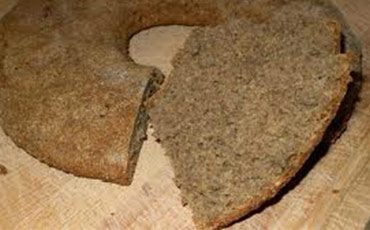
Oat bread
4 dl oat leaven you made before
about 8 dl different flours: oat, barley, graham, porridge leftovers etc.
3 tbsp caraway seeds
(salt if you like)
Mix other ingredients but caraway. Continue dough making in the table until the dough no longer sticks to the table. Let it stay for a moment. Form the breads and cover them with caraway seeds. Bake in 200 Celsius 50-60 minutes. Knock on the bottom of the bread: if the sound is hollow then the leaven is done and well baked.
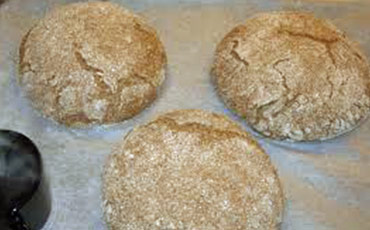
Barsja's bread
(2 big breads)
1500g flour mix: 250 g rye, 500g graham, 800 wheat flour
2 tbsp honey leaven you made before
8-9 dl water, warmth of 40 Celsius
2 tbsp caraway seeds
In the evening before: Mix coarse flours to the water the same way you would make porridge. Add leaven, mix it well. Let it stay overnight in a warm place. In the next morning add wheat flour, caraway and as much warm water you can to make the dough. Work the dough with hands for five minutes. Let it stay for an hour and bake. Let stay until it starts to raise. Bake in an oven of 250 Celsius for half an hour. Spread water on them before putting the loaves into the oven. Repeat it right after you took the loaves from the oven. Let the loaves cool under the towel. (Schöneck, p. 47).
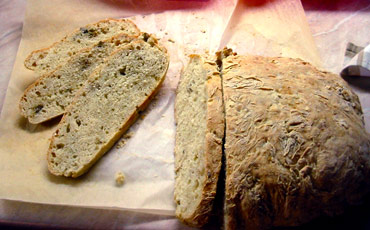
Salt and honey - bread
5 dl water, warmth of 40 Celsius
2 tsp salt
5 gr. honey
about 9 dl fresh flour
Start the process in the evening before. Mix water, salt and half amount of the flour. Use the mixer, since as much air as possible is needed to the mix. Add honey and the rest of the flour. Put the dough to the baking table. Mix it until it is soft and smooth. The dough should not be very tight, it has to be loose. It is very hard to work with a tight dough, but the results will be better. Put the bread into a pot with a cover, big enough that half of the space is left for raising. Let it raise in a room that has about 37 Celsius temperature for 14 hours. If the dough has not raised enough in the morning, let it stay a couple of hours more. If the loaves are well raised, bake at 180 Celsius for 2.5 to 3 hours. The not very well-raised ones should be baked this way: put the temperature for the first hour on 130 Celsius, then raise to 150 Celsius for 3-4 hours. (Luomuleipojan käsikirja, p.128).
Bibliography
Aaltonen, Turkka & Arkko, Matti: Yrttiopas, luonnonkasvit ravintona. Suomen matkailuliitto, 1986
Berger, Christian & DuboË- Laurence. Philippe: Oluen ystävän opas.Otava
Birkebaek: Oldtiden I, Vikingatiden.
Blamey, Marjorie & Grey-Wilson, Christopher: Otavan kasvitieto. Skotlanti, 1994
Dembinska, Maria: Food and Drink in Medieval Poland. University of Pennysylvania press, 1999
Genrup, Kurt: Mat som Kultur; Etnologiska kosthållstudier. Tidskrift för nordskandinavisk etnologi vol 5, Umeå Universitet 1988
Hagen, Ann: a Handbook of Anglo-Saxon Food, Processing and Consumption. Anglo-Saxon books, 1994
Hagen, Ann: a Handbook of Anglo-Saxon food, Production & Distribution. Anglo-Saxon books, 1995
Hess, Karen: Martha Washington’s Booke of Cookery. Columbia University Press, 1981
Israelsson, Isse: Mat på forntida vis, ide och receptsamling; Malmö museer (also published in Forntida teknik 2/89-1/90 as Forntida mat)
Johansson, Tomas: Att ätä som en stenåldersjägare; Forntida Teknik
Jäntti & Olkinuora: Tähkäpää, luomuleipojan käsikirja
Kulturhistorisk lexikon för nordisk medeltid; Akademiska bokhandeln 1976
Kytövuori, Pirjo & Hopsu-Neuvonen, Arja: Kanankaalista karpaloon, luonnonruokaa keväästä syksyyn. Marttaliitto ry 1995
Lampinen: Ruokaleipä ja sen valmistus
Moberg; Min svenska historia, det dagliga barkbrödet
Namez, Milton: Searching for a Structure in the Late Iron Age Settlement of the Åland Islands, Finland, Karhunhammas 15/1993
Rautavaara, Tapio; Mihin kasvimme kelpaavat, ruokaa, ryytiä ja rohtoa luonnosta, WSOY 1976
Retkeilykasvio. Suomen luonnonsuojelun tuki oy. Helsinki, 1984
Rousi, Arne: Auringonkukasta viiniköynnökseen, ravintokasvit, WSOY 1997
Sass, Lorna: Christmas Feasts from History.The Metropolitan Museum of Art, 1981
Schöneck, Annelies: Leipä, Hermes Oy, 1983
Seppä-Heikka, Merja: Esihistoriallisia siemeniä ja kasvipainanteita Paimion Sievolan myöhäisrautakautiselta asuinpaikalta.
Simonetti, Gualtiero: Makujen maailma, yrtit ja mausteet. Kolibri, 1990
Stead, Bourke ja Brothwell: Lindow Man the Body in the Bog; British Museum Publications, 1986
Storck, John & Teague, Walter Dorwin: Flour For Man’s Bread; A History of milling. Oxford University Press, 1952
Suominen, Juha & Hämet-Ahti, Leena: Kasvistomme muinaistulokkaat, tulkintaa ja perusteluja, Vammala 1993
Thunaeus, Harald: Mjödet genom tiderna. Daedalus 1954
Tolonen, Mirjami: Cereal Cultivation with Particular Reference to Rye: Some Aspects on Pollen-analytical Records from Sw. Finland; Fennoscandia Archaelogica II, Suomen arkeologinen seura, 1985Uusivirta, Hilkka: Suomalaisen ruokaperinteen keittokirja, WSOY 1982
Vehviläinen, Olli: Hiivan tarina
Viklund, Karin: Bröd, gröt och öl i forntiden; Aktuellt 93, Forntida teknik 1/93
Wilson, Anne C.: Food and Drink in Britain From the Stone Age to recent times.Penquin Books, 1084
Articles:
Bengtsson, Niklas: Elämän ja kuoleman eliksiirejä. HS 3.4.1997
Mannerkorpi, Jukka: Hunajaleipuri johtaa onneen; HS 3
Masonen, Jaakko: Maistui olut ennenkin. Tiede 2000 4/1992
Mausteet ehkäisevät homehtumista, Pirkka 1-2/96
Pakarinen, Aila: Kaalin hapattaminen sujuu aloittelijalta. HS
Skaarup, Bi: Sources of Medieval Cuisine in Denmark. In: Du manuscrit à la table, direct. Carole Lambert. Canada, 1992
Suomalaisille tarjotaan jälleen nälkämaan leipää; Itä-Helsingin Uutiset 27.3.1993
Tahkolahti, Jaakko: Pettu onkin terveellistä ja torjuu myös UV-säteilyn; HS 11.2.1997
Toiviainen, Lauri: Oluenpanosta todisteita jo 5000 vuoden takaa. HS 5.12.1992
Uudelleen keksitty pellava maustaa lakritsin ja sämpylän; HS 17.11.1994
HS= Helsingin Sanomat
Classes:
Vilkuna, Anna-Maija: Ruokatalous Hämeen linnassa 1500-luvulla. (Food Consumption in 16th century Häme castle) Suomen muinaismuistoyhdistys 4.12.1997
Conversations:
Linturi, Elsa. Archaeologist, University of Helsinki